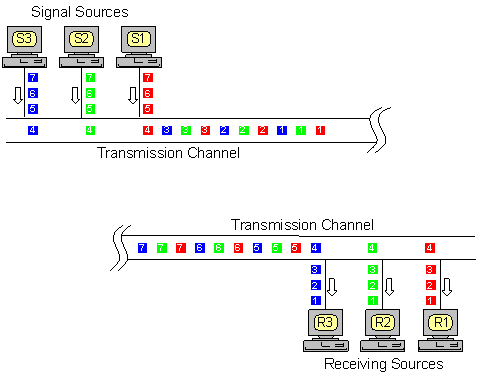Multiplexing and Demultiplexing
Transmission > Multiplexing and Demultiplexing
Multiplexing is the process in which multiple Data Streams, coming from different Sources, are combined and Transmitted over a Single Data Channel or Data Stream.
In Electronic Communications, the two basic forms of Multiplexing are Time Division Multiplexing (TDM) and Frequency Division Multiplexing (FDM).
In Time Division Multiplexing, Transmission Time on a Single Channel is divided into non-overlapped Time Slots. Data Streams from different Sources are divided into Units with same size and interleaved successively into the Time Slots.
In Frequency Division Multiplexing, Data Streams are carried simultaneously on the same Transmission medium by allocating to each of them a different Frequency Band within the Bandwidth of the Single Channel.
Multiplexing is done by an equipment called Multiplexer (MUX). It is placed at the Transmitting End of the communication link. At the Receiving End, the Composite Signal is separated by an equipment called Demultiplexer (DEMUX). Demultiplexer performs the reverse process of Multiplexing and routes the separated signals to their corresponding Receivers or Destinations.
Figure 1 shows how TDM interleaves small Units of each Data Stream into the corresponding Time Slots. It Transmits the Data Streams from three Signal Sources (Red, Green and Blue) simultaneously by combining them into a Single Data Stream.

Figure 1: Multiplexing and Demultiplexing
Transmission > Multiplexing and Demultiplexing
